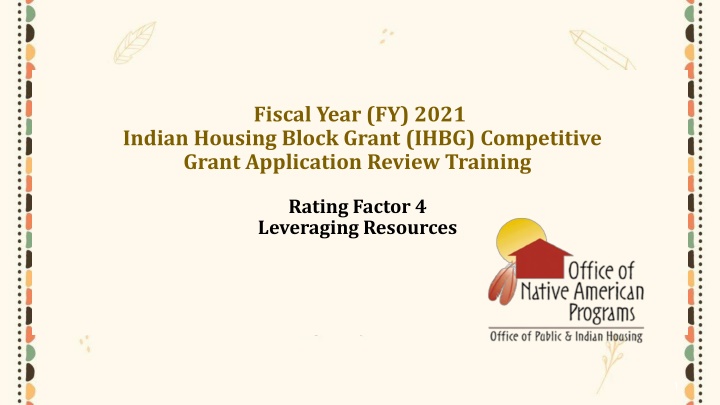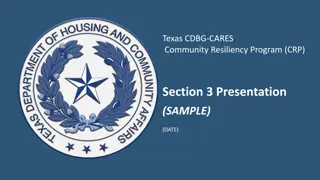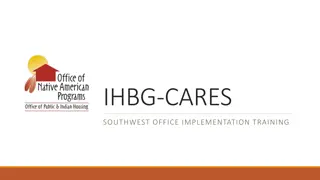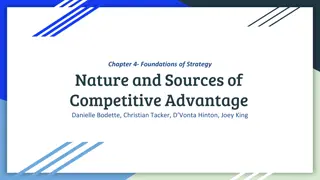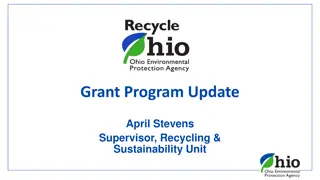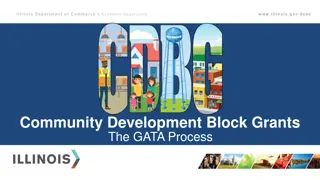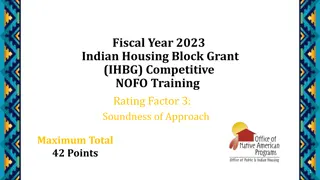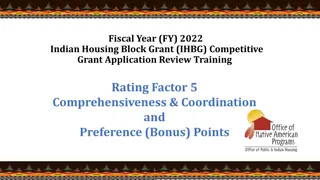Leveraging Resources in FY 2021 IHBG Competitive Grant Application
The FY 2021 IHBG Competitive Grant Application emphasizes Leveraging Resources as Rating Factor 4, where applicants can earn up to 5 points based on the percentage of leveraged resources relative to project costs. Firm commitments through cash or in-kind donations are encouraged, with examples including Tribal Resources, Federal Resources, and partnerships with Public Agencies or Foundations. The definition of Firm Commitment clarifies requirements for leveraging funds and the types of resources that qualify. Leveraged resources must be dedicated to the proposed project and incurred within the Period of Performance, excluding land acquisition costs before the application deadline. Leveraging both IHBG and non-IHBG funds is subject to specific guidelines.
Download Presentation

Please find below an Image/Link to download the presentation.
The content on the website is provided AS IS for your information and personal use only. It may not be sold, licensed, or shared on other websites without obtaining consent from the author.If you encounter any issues during the download, it is possible that the publisher has removed the file from their server.
You are allowed to download the files provided on this website for personal or commercial use, subject to the condition that they are used lawfully. All files are the property of their respective owners.
The content on the website is provided AS IS for your information and personal use only. It may not be sold, licensed, or shared on other websites without obtaining consent from the author.
E N D
Presentation Transcript
Fiscal Year (FY) 2021 Indian Housing Block Grant (IHBG) Competitive Grant Application Review Training Rating Factor 4 Leveraging Resources 1
Rating Factor 4: Leveraging Resources (Up to 5 points)) Percentage of Leveraged Resources Relative to Total IHBG Competitive Grant Projects Costs Points 25 percent or more 5 11 - 24 percent 3 5 - 10 percent 1 Note: Leverage percentage will be determined by firmly committed leveraged resources (total dollar amount) divided by the total cost of the project. 4 percent or less 0 Lowest American Indian Alaska Native (AIAN) per capita 3 2
Leveraging Resources No cost sharing or matching required. Leveraging (Federal and non-Federal) resources is encouraged. Applicants must provide firm commitments to be counted towards leveraging resources. Leveraging resources can include either cash or in-kind donations to be secured and used by the end of the period of performance. 3
Firm Commitment (Definition) Firm Commitment (page 10 of the Program NOFO) Letter of commitment, Memorandum of Understanding (MOU), or Agreement, Applicant s partner specifying that it agrees to perform and/or support an activity specified in the application. Demonstrate the partner has the financial capacity to deliver the resources or skills necessary to implement the proposed activity, Either in cash or through in-kind contributions, if HUD awards IHBG competitive funds. Tribal government, public agency, foundation, or private party may provide firm commitment as a partner. 4
Firm Commitment (Definition) With the exception of land acquisition, funds expended on the project prior to the application deadline date and period of performance start dates will not be counted as leverage. Applicants will NOT be allowed to spend leveraged dollars before approval of the Request for Release of funds, with exceptions of acceptable pre-award leveraging, Value of land acquisition Proposal costs Leverage resources must be for the same project proposed and incurred within same Period of Performance. Applicants are reminded that all IHBG requirements apply to the commitment or use of both IHBG and non-IHBG funds in a leveraged project. Federal sources are only allowed to be used as leveraging if permitted by a program s authorizing statute. 5
Examples of Leveraged Resources: 1) Tribal Resources 2) Federal Resources 3) Public Agency, Foundation or Other Private Party 4) Goods and Services 5) Land 6
Leveraging Resources 7 Leveraged Resource Evidence/Documentation Needed Tribal Resources or equivalent; the resolution (or equivalent) must identify the exact dollar amount (or value of resources to be committed.) For in-kind resources, specify dollar amount and method for valuation Tribal resolutions committing funds
Leveraging Resources 8 Leveraged Resource Federal Resources Evidence/Documentation Needed IHBG formula funds (whether administered by the tribe or a TDHE): Leveraging with current program year funds: o Most recently approved Indian Housing Plan (IHP). o Must identify the dollar amount. o Commit the IHBG resources to the project. o If not currently approved in the most recent IHP, an amendment to the IHP will be processed (if awarded). Future IHBG Funding: o Identify program year(s). o Identify the dollar amount of IHBG funds used.
Leveraging Resources 9 Leveraged Resource Federal Resources Evidence/Documentation Needed Other Federal Program Funds: U.S. Department of Agriculture, Indian Health Service, Bureau of Indian Affairs, Any other Federal agency. NOTE:If allowable by the federal program s statute, the applicant should submit statement (e.g. letter, email, etc.) from the federal agency approving the amount of funds to be committed for leveraging.
Leveraging Resources Leveraged Resource Public Agency, Foundation, or Other Private Party Evidence/Documentation Needed Letters of commitments which must include: The donor organization s name The specific funds proposed The dollar amount of the financial or in-kind resource The method of evaluation The purpose of that resource with the proposed project Signed commitment from an official of the organization legally authorized to make the commitment Memorandum of Understanding (MOU), and/or agreement to participate, including any conditions to which the contribution may be subject.
Leveraging Resources Leveraged Resource Goods and Services Evidence/Documentation Needed Must demonstrate the donated items are necessary to the actual development of the project. Must include comparable costs that support donation value.
Leveraging Resources Leveraged Resource Land used to determine land value will be acceptable. Evidence/Documentation Needed Tribal resolution or certification clearly identifies land value and method Land valuation must be established using one of the following methods and the documentation must be contained in the application. The application of land valuation documentation must state the method used to determine land value and identify the land value. The methods include: A site-specific appraisal no more than two years old. An appraisal of a nearby comparable site also no more than two years old. A reasonable extrapolation of land value based on current area realtor value guides. A reasonable extrapolation of land value based on recent sales of similar properties in the same area.
Leveraging Resources Leveraged Resource Evidence/Documentation Needed Land Land valuation must be established using one of the following methods and the documentation must be contained in the application. The application of land valuation documentation must state the method used to determine land value and identify the land value. Land previously used as leverage towards other ONAP competitions may not be proposed as leverage for this NOFO.
Leveraging Resources Leveraged Resource Land Evidence/Documentation Needed The methods used to determine value include: A site-specific appraisal no more than two years old. Tax assessments will be considered appraisals. An appraisal of a nearby comparable site also no more than two years old. A reasonable extrapolation of land value based on current area realtor value guides. A reasonable extrapolation of land value based on recent sales of similar properties in the same area.
Leveraging Resources 15 Leveraged Resource Evidence/Documentation Needed Land previously used as leverage towards other ONAP competitions may not be proposed as leverage for this NOFO. Land
Leveraging Resources (SF-425): Grantees will be required to show evidence that leveraging resources were actually received and used for their intended purposes through quarterly reports (SF-425) as the project proceeds. 16
Leveraging Resources (Unavailable resources): HUD recognizes that in some cases, the applicant cannot receive a firm commitment of non-tribal funds by the application deadline. If so, the applicant must include a statement from the contributing entity that describes why the firm commitment cannot be made at the current time. Statement must say that the tribe/organization and proposed project meets the eligibility criteria for receiving the leveraged funds. Statement must also include a date by which the funding decisions will be made, which cannot be over six (6) months from the anticipated date of grant approval by HUD. 17
Leveraging Resources (Evidence): If the applicant does not provide HUD with evidence of the firm commitment from the original leverage source or an alternative source within 6 months of the date of grant approval, or if anticipated leverage is not provided, HUD will re-rate and re-rank the application with the updated lower leverage. If the application is no longer fundable after re-rating and re-ranking the application, HUD will rescind the grant and recapture grant funds. 18
Leveraging Resources (Percentage): HUD will award points based on percentage of leveraged resources committed relative to (total) IHBG Competitive project costs. Applicants who propose leveraging but do not provide firm commitment documentation for those (particular) sources of leveraging, those sources of leveraging will not be included in the total leverage resources amount. 19
Leveraging Resources (Percentage): Percentage % = Total Leverage Resources (Firmly Committed Dollar Amount) / Total Grant Project Costs 20
Leveraging Resources (Percentage): Percentage % will be determined by; Total Leveraged Dollar Amount (leverage attachments) Application for Federal Assistance (SF-424) 21
Leveraging Resources (Percentage): SF-424, page 3 (Line 18 (Estimated Funding)) 18 Estimated Funding ($) 18a-Federal 18g-Total 22
Leveraging Resources (Percentage): Percentage Calculation Sample 1: Leverage Entry Dollar Amount Tribal Resolution (tribal funds) $1,000,000 IHBG Future Funds ($100,000/year/5 years) $500,000 Land (land appraisal) $167,000 Total Dollar Amount Firmly Committed = Leveraged Amount $1,667,000 Total Grant Requested (SF-424 (Line 18a)) $5,000,000 Total Project Costs= Total Grant Requested + Leveraged Amount $6,667,000 23
Leveraging Resources (Percentage): Percentage Calculation Sample 1: Percentage % = Total Leveraged Amount/Total Grant Project Costs $1,667,000 / $6,667,000 = .25 or 25% Leveraged Percentage equals 25% Applicant will receive 5 points Earned percentage is at 25% 24
Leveraging Resources (Percentage): Percentage Calculation Sample 2: Leverage Entry Dollar Amount Tribal Resolution (tribal funds) $500,000 IHBG Current Future Funds $300,000 Private Party $200,000 Total Dollar Amount Firmly Committed = Leveraged Amount $1,000,000 Total Grant Requested (SF-424 (Line 18a)) $4,000,000 Total Project Costs= Total Grant Requested + Leveraged Amount $5,000,000 25
Leveraging Resources (Percentage): Percentage Calculation Sample 2: Percentage % = Total Leveraged Amount/Total Grant Project Costs $1,000,000 / $5,000,000 = .20 or 20% Leveraged Percentage equals 20% Applicant will receive 3 points Earned percentage between 11 and 24% 26
Leveraging Resources (Economic Distress): Indian tribes and TDHEs with significant challenges leveraging funds Severely distressed economic, housing and infrastructure conditions in tribal communities. HUD 2017 Housing Needs Study American Indian and Alaska Native (AIAN) reservations and tribal area with severe problems. Remoteness, lack of infrastructure, complex legal constraints related to land ownership. Difficulty in improving housing conditions. Challenges lead to inability to leverage funds. 27
Leveraging Resources (Economic Distress): Three (3) points awarded to applicants that have difficulty leveraging funds. Access AIAN incomes in each Indian tribe s IHBG formula area. Three (3) points awarded to bottom 25 percent of Indian tribes that received FY 2020 IHBG Formula funding. Lowest AIAN per capita income. Area AIAN per capita income determined lesser of multi- race or single-race estimate in IHBG formula area 2011-2015 American Community Survey (ACS) data. 28
Leveraging Resources (Economic Distress): HUD has provided a list of all tribes at the website https://www.hud.gov/program_offices/public_in dian_housing/ih/grants/ihbg_cgp (under the link Tribal Area PCI RF4 Resource Only), which include per capita income estimates. Report will indicate which Indian tribes that will qualify for the three (3) points under Leveraging Resources. 29
Leveraging Resources (Economic Distress): Please view sample chart below Per Capita Income (25th percentile threshold is LE $11,227) Qualify for leverage (0=No; 1=Yes) 0 1 1 1 0 0 Source for lowest Per Capita Income Formula Area single Census tribal area single Census tribal areas multi Census tribal areas multi Census tribal area single Census tribal area single tribcode 20010ALASKA 20020CHICAGO 20030DENVER 20040OKLAHOMA 20050PHOENIX 20060SEATTLE Office Tribe Name Tribe A Tribe B Tribe C Tribe D Tribe E Tribe F $12,850 $7,862 $11,117 $8,454 $16,820 $18,348 Column E (Qualify for Leverage (0=No; 1=Yes)) will determine, which tribe/TDHE will quality for points. If tribe/TDHE listed indicates 1 under Column E, then applicant will qualify for 3 points under Leveraging Resources. If tribe/TDHE listed indicates 0 under Column E, then applicant will not qualify for 3 points, in which leverage percentage requirements will apply. 30
